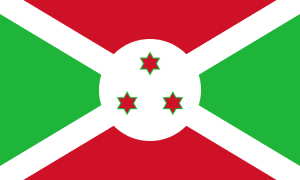
| Colors | HEX Code | RGB | CMYK |
|---|---|---|---|
| Red | #CE1126 | 206, 17, 38 | 0, 92, 82, 19 |
| White | #FFFFFF | 255, 255, 255 | 0, 0, 0, 0 |
| Green | #1EB53A | 30, 181, 58 | 83, 0, 68, 29 |
The Burundi flag is made of two red opposite triangles at the top and bottom sides of the flag, and two green opposite triangles to the left and the right. The flag features a white disk in the middle of the flag, where two white lines extend diagonally across the flag. Within the white disk, there are three red, six-pointed stars edged with green.
Meaning of the Burundi flag
The Burundi flag features the red color which symbolizes the struggle for independence and the blood that was shed to free the country. The white color represents peace and the future aspirations of the people. The green color represents hope and future development. The three stars carry multiple cues. They represent the three ethnicities that inhibit Burundi which are the Tutsi, Hutu, and Twa. They are also thought to represent loyalty to God, king, and country. The three stars were recently linked to the national motto of Burundi “Unity, Work, progress.”
History of the Flag
Burundi is a small, landlocked country in east-central Africa. In the 18th and 19th centuries, the country was a German colony, which shared its flag with other countries in central Africa. After WWI, the rule moved to Belgium, and the flag was representative of the new colonial power. However, Burundi sought independence and was able to attain it in 1961. As a result, a new flag was officially hoisted. The new flag featured the karyenda drum, which is a traditional symbol of the country, propping up on top of a sorghum plant, a national agricultural product. When the monarchy ended in 1966, the flag was changed again. In 1967, the current Burundi flag with all its historical and social implications was officially adopted.